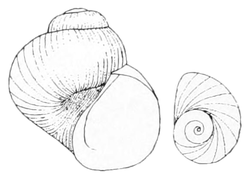| Clappia | |
|---|---|
 | |
| Drawing of apertural view of the shell and its operculum of Clappia umbilicata | |
| Scientific classification | |
| Kingdom: | Animalia |
| Phylum: | Mollusca |
| Class: | Gastropoda |
| Subclass: | Caenogastropoda |
| Order: | Littorinimorpha |
| Superfamily: | Truncatelloidea |
| Family: | Lithoglyphidae |
| Genus: | Clappia Walker, 1909 [1] |
Clappia was a genus of small freshwater snails that have an operculum, aquatic gastropod mollusks in the family Lithoglyphidae. [2] [3]
Generic name Clappia is in honor of malacologist George Hubbard Clapp. [1]

